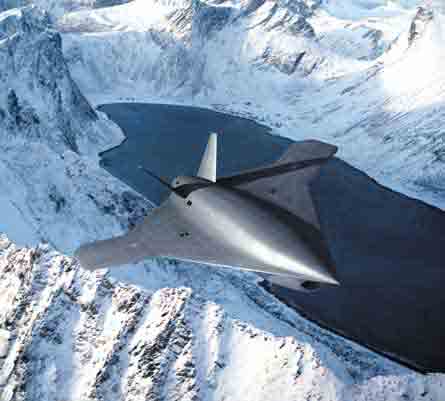The MoD has outlined its national research and technology objectives for the next 20 years. Can industry deliver?
Airborne radar, electronic warfare equipment and unmanned air systems (UAS) are among a broad range of key technologies identified in a long-term strategy document released by the UK Ministry of Defence last week. Compiled as a companion to the UK Defence Industrial Strategy (DIS) published last December, the Defence Technology Strategy (DTS) outlines the MoD's research and development needs for the next 20 years.
"There is a need for speed in the research sector, as the investments we make today will determine our capability in the future," says UK minister for defence procurement Lord Drayson. The UK government and industry, including small and medium-sized enterprises (SME) and start-ups, should invest more heavily in defence research and technology (R&T), particularly during the research phase, he says. "The key focus is on the pull-through of research to frontline capability. We want useful products that can be applied more rapidly."
The UK government has outlined a strategy to increase cross-sector research spending from 1.9% to 2.5% of the nation's gross domestic product by 2014. "I will certainly be arguing for more [state] money for research," says Drayson, while noting that the defence industry must also play its part by increasing last year's spend of just 2% of a £12.2 billion ($22.6 billion) turnover on R&D.
|
|---|
The MoD will fund more UAV demonstrations under the DTS |
The new document identifies a large number of technology areas in which the UK should retain national capability to produce and/or support its military equipment, develop systems in collaboration with other nations, retain so-called "intelligent customer status" or acquire capability off the shelf. "We clearly can't do everything," Drayson notes.
The MoD should look to pull through more military technologies from the civilian sector, Drayson says, while also offering greater incentives for companies to invest in potentially transformational technologies, despite potentially limited returns from the military sector. "If they innovate and get it right the returns should be higher," he says. "Part of the mix is reward."
In the air sector, the ability to develop and support advanced airborne radars such as active electronically scanned arrays is a key priority. "We will continue to work with the supply base in the planning of R&D to further align MoD and private venture spend in fixed-wing radar systems," the DTS says.
"It is considered vital that the UK retains a capability in radio frequency directed energy weapons and highly desirable that a national capability is retained on defensive laser systems," the document says. It also outlines a plan "to ultimately deploy one indigenous type of infrared missile approach warning sensor across the air fleet" for self-protection purposes.
In the unmanned air vehicle sector, the DTS says: "We will work with the supply base to develop and refine through-life models of UAV ownership, validated by successive platform and mission demonstrators." Key technology areas to be addressed through this process include autonomy, payloads, data management and automatic target recognition, it says. However, noting the complexities yet to be overcome in operating autonomous systems, it adds: "The UAS is unlikely to displace manned types for the lives of [the Eurofighter] Typhoon and JCA [Joint Combat Aircraft Lockheed Martin's F-35]."
The MoD is, meanwhile, to form a Rotorcraft Technology Steering Committee by the end of this year to co-ordinate future investment in the helicopter sector by the UK government and leading players such as AgustaWestland. "Current MoD planning suggests that a demand for a step change to advanced configurations [such as tiltrotor technology] is unlikely before 2040," the DTS says.
Discussing earlier suggestions that the UK should establish a national equivalent to the US Defense Advanced Research Projects Agency (DARPA), Drayson says he favours replicating some of the organisation's best features within the UK's state-owned Defence Science and Technology Laboratory. The DTS, meanwhile, outlines an initiative to sponsor a contest using autonomous and semi-autonomous systems in a complex urban environment, inspired by DARPA's Grand Challenge unmanned ground vehicle project.
Drayson says the MoD and UK firms must be prepared to co-operate with companies and organisations in the USA and Europe. "It is important for us to collaborate with the USA, but we have challenges with the US technology-transfer process," he says, citing continuing negotiations with Washington over the F-35 project. Drayson is cautious on suggestions from the European Defence Agency (EDA) that its partner nations should collaborate in all their military research activities. He welcomes the EDA input, but is encouraging it to work on "specific projects that would make a real difference".
Prime contractors have been swift to welcome the content of the new document. "The DIS and now the linked DTS will help provide the clarity industry needs to plan investment in developing key technologies," says BAE Systems. EADS UK notes: "One of the challenges that remains is to break down the silos between defence and civilian technology and capability. The defence world still has a lot to learn and to gain from the civilian market and from civilian platforms and technology."
The UK's SMEs have been less glowing in their analysis of the MoD's plans. "We want to see the MoD commit to manage the supply chain, and industry must support it in safeguarding SMEs," says Ivor Bennett, managing director of BMT Sigma. "If the market is dominated by a few major companies, how do you maintain value for money, creativity and innovation?"
Source: Flight International

















